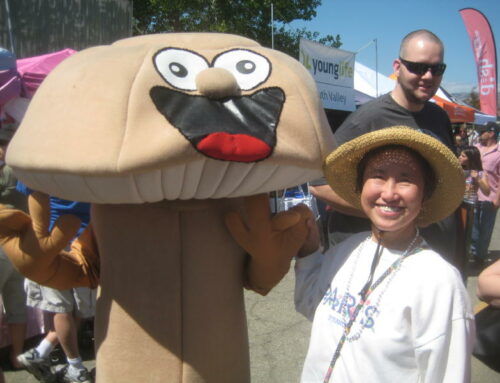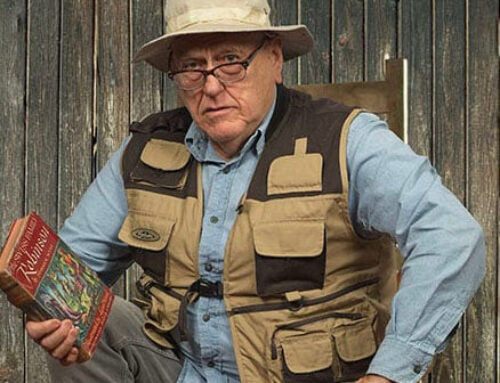Villagers insisted she learn in exchange for teaching them how to grow vegetables
Published in the November 11-24, 2015 issue of Morgan Hill Life
By Staff Report

Photo by Marty Cheek
Lesley Miles displays some of the weavings she created while teaching gardening to villagers in Guatemala 40 years ago. Some of the weavings were done by villagers and given to her.
Four decades ago, Morgan Hill architect Lesley Miles worked as a volunteer in Guatemala for an organization called the Direct Relief Foundation. In a village located in the Todos Santos region in that Central American country, she spent a year teaching people how to make family gardens as health resource centers. In turn, they taught her the skill of weaving elaborate huipiles (or backstrap-loomed tops).
Miles carefully saved the huipiles she made and received from the villagers. In honor of the people of Todos Santos, Nov. 1 she opened a special art collection display of these weavings called “Woven Voices of Guatemala” in The Granary, the downtown building where Miles and her husband, Charles Weston, work in their Weston Miles Architects business.
“I decided to have this opening because today is their saint’s day and it was 40 years ago that I was there,” Miles said at the grand opening of the exhibit. “When I was there, I taught vegetable gardening, but in exchange no one wanted me to just teach them something, we had to have a fair trade, so I ended up learning how to weave.”
Done traditionally by women, the huipiles weaving is extremely fine and Miles learned how produce an inch to three-quarter of an inch of the handwoven pieces in two hours. The exhibit collection includes vintage pieces from the 1950s and represents the traditional garments worn by the Mam, Ixil and Quiche indigenous peoples of Guatemala.
The highly decorated garments on display are made from fibers that were specially prepared before weaving. Soaking the threads in cornstarch gave the weaver ease in her work and insured the durability of the garment, Miles said. The different patterns and colors indicate the various regions of Guatemala.
“Like stories passed down from one generation to the next, the unique weaving skills and patterns of the different villages unified the people and created a textile lineage,” she said.

Photo courtesy Lesley Miles
Lesley Miles, center, learns the art of huipile weaving from two youngsters in Guatemala almost 40 years ago.
The Woven Voices of Guatemala display is the inaugural art exhibit for the Granary Installation Space located in a hallway in the back of the LEED-certified building on Depot Avenue. The space will be available to artists and collectors with “a unique point of view,” Miles said. Exhibits may be submitted for consideration. If an artist is interested in displaying a work or collection, she encourages him or her to send a proposal by emailing her a [email protected].
Jessica Pirrir-Alvarez, a Morgan Hill resident whose parents came from Guatemala, was impressed with the huipiles in the exhibit at the Granary. She came to the opening with her mother Josefa Locon, husband Edwin Alvarez, and niece Sarah.
“I think it’s really amazing because not a lot of people get to see this,” Pirrir-Alvarez said. “A lot of people don’t know much about Guatemala. They know about Mexico but not about Guatemala and all the textiles that come from there — and now they get to see it.”
The huipiles exhibit taught her information about her heritage because she wasn’t “involved” with her own Guatemalan culture, she said.
“Each region has its own style,” Pirrir-Alvarez said. “I would say to people to come and see the gallery and get a hint of Guatemala and a small taste of the culture. Guatemala is very colorful.”
After graduating from college where she had received a degree in horticulture, Miles became interested in organic farming and teaching. She decided to take off a couple of years and join the Direct Relief Foundation, a group similar to the Peace Corps. The group sent her to the village of Primer Centro in the northwestern area of Guatemala to teach its residents how to eat healthier to have long, productive lives — particularly children. Malnutrition is one of the problems to deal in this part of the world principally because people do not have fresh fruit and vegetables, she said.
Miles was in Guatemala from 1977 to 1978, helping people in the village of Primer Centro learn to plant and tend vegetable gardens.
“The wonderful thing for me was also having an opportunity to be in a community of 15 families where we had no electricity, no running water, we had no communication with the outside world, and so it was really an opportunity to be in an isolated community and what that meant,” she said. “I probably learned more than they did.”
The people of Guatemala faced a devastating civil war from 1960 to 1996 fought between the government and various leftist rebel groups. The government forces of Guatemala committed genocide against the Mayan population and participated in widespread human rights violations against civilians.
“The village of Primer Centro, inhabited by the people of Todos Santos, no longer exists due to the war,” Miles said. “However, as long as the integrity of the fibers and the energetic imprint from the weavers of these garments lives on, so will the stories of the people. This display is in honor and memory of the people and the very fine weavers that once lived there.”
The Woven Voices of Guatemala collection will be on display at the Granary Installation Space until Dec. 31.





